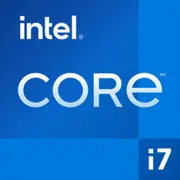Intel Core i7-4940MX

Intel Core i7-4940MX in 2025: A Retrospective and Relevance
Examining who might benefit from the legendary mobile processor a decade after its release
Architecture and Technology Process: The Legacy of Haswell
The Intel Core i7-4940MX processor, released in 2014, became a flagship model in the Haswell lineup. Its architecture, built on a 22nm technology process, brought several enhancements compared to the previous Ivy Bridge generation.
Cores, Threads, and Clock Speeds
- 4 Cores/8 Threads: Thanks to Hyper-Threading, the processor efficiently handles multitasking.
- Clock Speeds: Base frequency — 3.1 GHz, maximum in Turbo Boost mode — 4.0 GHz (for one core). For all four cores, the turbo frequency reaches 3.6–3.8 GHz.
- Cache: An 8 MB L3 cache accelerates data processing, which is critical for rendering and complex calculations.
Integrated Graphics Intel HD 4600
- Support for DirectX 11.1, OpenGL 4.3, and 4K displays.
- 20 Execution Units (EUs) with a frequency of up to 1350 MHz.
- In 2025, this is sufficient only for basic tasks: office applications, 4K video playback, older games at low settings (for example, CS:GO at 720p delivers about 40–50 FPS).
Innovations of Haswell
- Improved IPC (5–10% higher than Ivy Bridge).
- Energy efficiency: despite a TDP of 57W, Haswell managed power consumption better during idle states thanks to C-states technology.
Power Consumption and TDP: The Balance of Power and Heat
TDP 57 W — this is a high figure even for modern gaming laptops. In 2025, most ultrabooks use chips with TDPs of 15–28 W (for example, Intel Core i7-1360P).
Cooling Features
- Laptops with the i7-4940MX required massive cooling systems with multiple heat pipes and fans.
- Without proper cooling, the processor would quickly overheat, leading to throttling (frequency reduction).
Power Saving Technologies
- Intel SpeedStep: Dynamic frequency adjustment based on load.
- Turbo Boost 2.0: Automatic core overclocking when thermal headroom is available.
Performance: Benchmarks in 2025
By the standards of 2024–2025, the i7-4940MX appears modest, but for its time, it was a powerhouse.
Office Work and Multimedia
- Geekbench 6: 1216 (Single-Core), 3773 (Multi-Core).
- Modern counterparts: For example, the AMD Ryzen 5 7600U (2023) scores ~2300/8500 points.
- Practical Tasks:
- Opening 20 tabs in Chrome + Photoshop: possible stuttering.
- Video conversion in HandBrake (1080p to 720p): ~40–50% slower than Intel Core i5-1240P.
Gaming
- With integrated graphics: Only lightweight projects (Minecraft, Dota 2) at low settings.
- With a discrete GPU (for example, NVIDIA GTX 980M): In 2025, such systems can still run Apex Legends at medium settings (60 FPS, 1080p).
Turbo Boost Mode
- Under load on 1–2 cores, the frequency rises to 4.0 GHz, speeding up rendering in Photoshop.
- However, under full load across all cores (for example, rendering in Blender), the frequency drops to 3.6–3.8 GHz due to overheating.
Usage Scenarios: Who Is It Relevant for in 2025?
1. Budget Enthusiasts: Laptops with the i7-4940MX can be found on the second-hand market for $150–300. This is a cost-effective way to build a system for programming or CAD work.
2. Retro Gaming: Paired with a discrete GPU from 2014–2016 (GTX 900M, Radeon R9 M300), the laptop can handle games from the past decade.
3. Office Tasks: If heavy applications are not required, the processor still operates reliably.
Autonomy: A Weak Point
With a TDP of 57 W, battery life remains an issue even in 2025:
- Standard Battery Capacity in 2014 laptops — 60–80 Wh.
- Real Scenarios:
- Web browsing: 2.5–3 hours.
- Standby: up to 4 hours thanks to power-saving technologies.
Power-Saving Tips:
- Disable Turbo Boost through Windows power settings.
- Install Linux with a lightweight DE (XFCE, LXQt).
Comparison with Competitors
AMD FX-7600P (2014):
- 4 Cores/4 Threads, TDP 35 W.
- Lagged in single-thread performance (~20%), but was cheaper.
Intel Core i7-4930MX (Ivy Bridge):
- Previous generation. The i7-4940MX is 10–15% faster due to Haswell optimizations.
Apple A17 Pro (2023):
- A modern chip in the MacBook Pro. In Multi-Core (Geekbench 6), it scores ~12000 points — 3 times more than the i7-4940MX.
Pros and Cons
Strengths:
- High performance for 2014.
- Unlocked multiplier (overclocking possible up to 4.2–4.4 GHz).
- Supports up to 32 GB DDR3L-1600.
Weaknesses:
- High TDP and heating.
- Outdated platform: lack of USB 3.1, Thunderbolt 3, NVMe.
Recommendations for Choosing a Laptop
In 2025, new devices featuring the i7-4940MX are not being released, but you can find:
- Gaming Laptops: MSI GT70, Clevo P150SM — check the condition of the cooling system.
- Workstations: Dell Precision M4800 — convenient for upgrades (SSD replacement, RAM addition).
What to Pay Attention To:
1. Thermal Paste: Replace it before purchasing.
2. Battery: Will likely need to be replaced.
3. Ports: Ensure necessary connections (HDMI, USB 3.0) are available.
Final Thoughts
The Intel Core i7-4940MX in 2025 is a choice for:
- Enthusiasts looking to build a budget powerhouse system for retro gaming or working with legacy software.
- Professionals in need of an inexpensive laptop for testing software on outdated hardware.
Key Benefits:
- Low price on the second-hand market.
- Upgrade potential (memory, SSD).
- Nostalgic factor for retro tech enthusiasts.
If you are looking for a laptop for modern tasks, consider models with Intel Core 12th–14th generation processors or AMD Ryzen 7000. Their prices start from $800, but they offer 3–5 times higher performance and 8–10 hours of autonomy.
Basic
CPU Specifications
Memory Specifications
GPU Specifications
Benchmarks
Compared to Other CPU
Share in social media
Or Link To Us
<a href="https://cputronic.com/index.php/cpu/intel-core-i7-4940mx" target="_blank">Intel Core i7-4940MX</a>